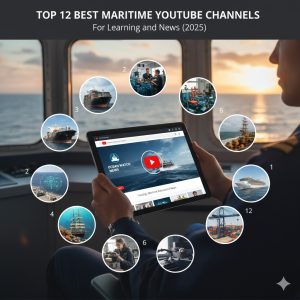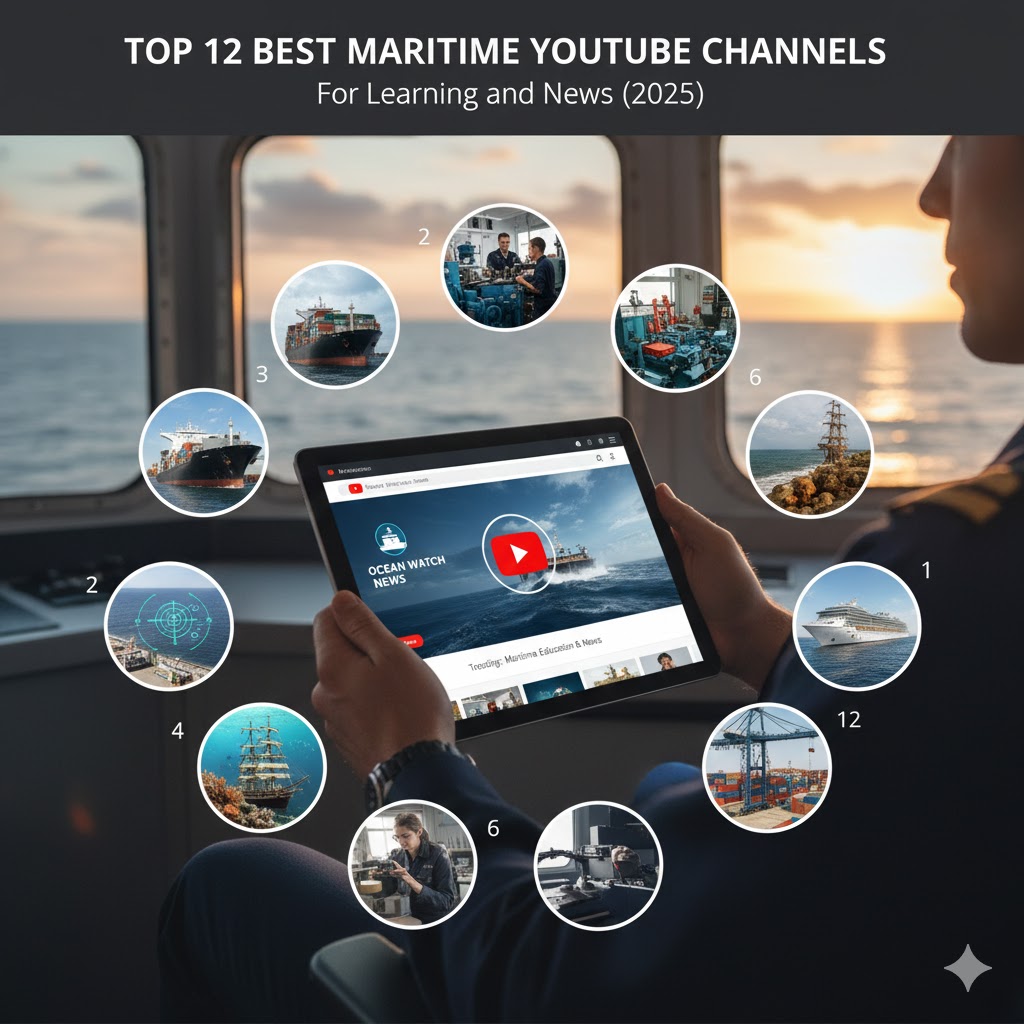
Discover the 12 best maritime YouTube channels for learning, career growth, and industry news—from IMO policy and safety to ship handling, tech, and history.
Your “always-on” classroom at sea (and ashore)
Maritime YouTube has quietly become one of the best classrooms in the world. Whether you’re a cadet preparing for STCW assessments, a chief officer tracking decarbonisation rules, an ETO brushing up on automation, or a curious enthusiast, the right channels can turn idle minutes into real learning. But there’s a problem: search “maritime” on YouTube and you’ll drown in mixed-quality content—great tutorials buried among clickbait storms and “fastest ship” compilations. This guide curates the Top 12 maritime YouTube channels for learning and news in 2025. We blend official sources (regulators and class), respected industry media, and standout educator-creators. For each channel, you’ll find what it’s best for, who should watch, and representative examples—so you can subscribe with confidence.
Selection criteria: clear educational value, accuracy, frequency, authority, relevance to modern shipping (safety, regulation, technology, markets, careers), and accessibility for global English readers.
Why maritime YouTube matters in modern operations
Shipping is changing faster than syllabi. The 2023 IMO GHG Strategy, FuelEU Maritime, Mediterranean SECA, alternative fuels (LNG, methanol, ammonia), digitalisation, and evolving safety culture mean that continuous learning is now part of every rank’s job description. The best channels help you:
- Decode new rules with official explainers and recorded webinars.
- Track safety lessons from recent accident investigations to avoid repeat failures.
- Understand markets and geopolitics affecting routing, risk, and freight.
- Master ship handling and engineering concepts through high-quality visualisation and simulator-based tutorials.
The Top 12 Maritime YouTube Channels (Learning + News)
Ordered to give you a balanced “playlist”: policy & safety, technical learning, market/news, and history/context.
1) MaritimEducation
Best for: Practical tutorials, STCW-aligned training explainers, safety awareness, and career guidance for cadets and junior officers.
Why watch: MaritimEducation focuses on clear, step-by-step demonstrations of both deck and engine room tasks—from COLREGS and mooring safety to engine watch rounds and fuel handling. Videos are designed with simple English, helpful visuals, and scenario-based walk-throughs, making them accessible to global learners and effective for onboard training refreshers. The channel also covers seafarer career development, including exam preparation, oral interview tips, and guidance on documenting sea-time.
Who it’s for: Cadets, junior officers, maritime students, and training officers looking for reliable video content to support blended learning and safety briefings.
2) International Maritime Organization (IMO)
Best for: Official global rules, safety/environment briefings, awareness days, decarbonisation messaging.
Why watch: The UN agency that sets SOLAS, MARPOL, STCW shares concise explainers, campaigns (e.g., women in maritime), and playlists you can cite for training.
Who it’s for: Officers, DPAs/HSSE managers, lecturers building compliant course packs.
3) European Maritime Safety Agency (EMSA)
Best for: EU safety/compliance, FuelEU Maritime, Med SECA, surveillance services, ports & inspections.
Why watch: EMSA publishes webinars and highlight reels summarising reporting/compliance and training findings—practical context for EU-trading vessels.
Who it’s for: EU operators, compliance teams, masters/CEs preparing for port State control.
4) Marine Accident Investigation Branch (MAIB)
Best for: Learning from incidents, human factors, procedural gaps, and design issues.
Why watch: Short talks and case-based explainers illuminate what went wrong and the lessons learned—ideal for safety meetings and toolbox talks.
Who it’s for: Masters, safety officers, training officers, cadets before first sea phase.
5) DNV Maritime
Best for: Class guidance, decarbonisation roadmaps, technology briefings, data platforms.
Why watch: DNV’s webinars, “Maritime Forecast to 2050” launches, and podcast episodes compress complex regulation-tech-finance dynamics into digestible sessions.
Who it’s for: Technical managers, superintendents, chartering teams evaluating fuel pathways.
6) Lloyd’s Register (LR)
Best for: Class perspectives on safety, human element, heritage, and energy transition.
Why watch: LR shares project stories, safety culture films, and decarbonisation hub insights—great references for SMS training and leadership workshops.
Who it’s for: HSQE leaders, fleet HR/L&D, maritime historians/educators.
7) What’s Going On With Shipping? (Sal Mercogliano)
Best for: Timely news, policy analysis, port conditions, geopolitics, casualty commentary.
Why watch: A maritime historian offers daily/weekly analysis with charts and source links; ideal for managers who need signal amid noise.
Who it’s for: Executives, ops/chartering teams, maritime journalists, students following current events.
8) Seatrade Maritime News
Best for: Concise market reviews (“Maritime in Minutes”), event interviews, trend commentary.
Why watch: Newsroom-style videos that summarise the month in shipping—quick “catch-up” for busy professionals.
Who it’s for: Analysts, students writing essays, media/PR pros.
9) The Maritime Executive (TME)
Best for: Executive interviews, policy & port leadership viewpoints, and topical deep dives.
Why watch: The channel complements TME’s site with “In The Know” interviews—first-hand insights from CEOs, class leaders, and port directors.
Who it’s for: Strategy teams, port professionals, policy watchers.
10) Casual Navigation
Best for: Ship handling, navigation, COLREGS, simulators, and case-study storytelling.
Why watch: High production, clear pedagogy, frequent use of simulators and whiteboard-style visuals; broad appeal from cadets to masters.
Who it’s for: Deck tracks, pilots-in-training, anyone who learns visually.
11) MAN Energy Solutions (Marine)
Best for: Propulsion tech (dual-fuel, retrofits), turbochargers, digital optimisation, collaboration with OEMs.
Why watch: Marine tech playlists give concise briefings useful for CEs, superintendents, and energy-transition planning.
Who it’s for: Engineers, technical managers, procurement, chartering.
12) Oceanliner Designs
Best for: Maritime history, naval architecture context, and “what happened?” reconstructions that sharpen risk thinking.
Why watch: Engaging long-form storytelling on design/accident narratives—from the liner era to modern vessels—helps crews internalise design-meets-operations lessons.
Who it’s for: Lecturers, maritime historians, learners who retain concepts via story.
–
How to use these channels for structured learning
-
Build a weekly watchlist
-
Regulation/Safety (IMO, EMSA, MAIB): 1–2 videos/week for compliance currency.
-
Tech/Decarbonisation (DNV, LR, MAN ES): webinar or podcast per fortnight.
-
News/Markets (WGO Shipping, Seatrade, TME): weekly wrap plus one interview.
-
Skills/Context (Marine Insight, Casual Navigation, Oceanliner Designs): 2–3 videos for practical skills + historical perspective.
-
Flip the classroom
Assign a video before toolbox talks or cadet seminars; use the clip to spark discussion and link back to STCW model courses and your SMS. -
Cite official explainers
In training records and ISM audits, link IMO/EMSA/MAIB clips in induction packs to demonstrate awareness and ongoing competence.
Case studies: Real-world applications
A. Preparing for Med SECA (Mediterranean Sulphur ECA)
A regional operator compiled a 45-minute playlist from EMSA webinars and IMO explainers to brief deck/engine teams, then added DNV/LR clips on fuel choices and reporting. Result: fewer bunkering errors, faster document checks, and better crew confidence during PSC.
B. Preventing repeat incidents
After two near-misses with mooring line snap-back, a bulk carrier used MAIB lessons-learned videos plus Marine Insight’s mooring explainer to standardise a visual briefing for cadets and ABs.
C. Executive decision-making
Amid Red Sea diversions and tariff uncertainty, a small liner’s leadership followed Seatrade’s “Maritime in Minutes” and Sal Mercogliano’s weekly briefings to adjust schedules and customer communications—cutting idle time and improving schedule reliability.
Future outlook: The next wave of maritime learning on YouTube
Expect more live streams, shorts for micro-learning, and OEM collaborations that translate R&D into crew-ready language. Regulation videos will expand to FuelEU compliance, e-logbooks, and GHG intensity tracking, while creators double down on simulator-based explainers for ship handling and emergencies.
FAQ (for rich-snippet/FAQ schema)
1) Are these channels suitable for STCW exam prep?
Yes—especially Casual Navigation (COLREGS/handling) and Marine Insight (operations). Always pair videos with your academy’s syllabus and IMO model courses.
2) Which channels are best for regulatory updates?
IMO and EMSA for official context; DNV/LR translate rules into practice; Seatrade/Maritime Executive/What’s Going On With Shipping add market impacts.
3) Can I use these videos in company training?
Generally yes (public links), but check each channel’s terms. Many firms embed official clips in induction and safety meetings.
4) What about ocean science/environment?
NOAA / Ocean Today playlists cover hazards, sanctuaries, and climate-ocean basics—perfect for E-Navigation, metocean briefings, and youth outreach.
5) Which channel is best for executives pressed for time?
Seatrade’s “Maritime in Minutes” and What’s Going On With Shipping weekly/even-daily briefs.
6) Any academic channels?
WMU provides e-learning teasers and events aligned with the IMO academic pathway.
7) Is there a single “best” channel?
No—pair official + class for compliance and media + creators for timely analysis and practical understanding.
Conclusion
Maritime YouTube, when curated, is a career force-multiplier. Subscribe to IMO/EMSA/MAIB for safety and rules; DNV/LR/MAN ES for tech and decarbonisation; Seatrade/TME/Sal Mercogliano for news and markets; Marine Insight/Casual Navigation/Oceanliner Designs for skills and context. Turn commute time into CPD, and share playlists across your fleet or classroom.
If you run training or manage a fleet, build a quarterly “learning pathway” with the channels above. Tie each clip to company SMS, STCW competencies, and port State expectations—and keep your teams one step ahead.
References & further reading (authoritative)
-
International Maritime Organization (IMO) – Conventions, Model Courses, safety/environment programmes.
-
STCW @ IMO – Training/competence standards.
-
European Maritime Safety Agency (EMSA) – Video gallery, FuelEU/Med SECA briefings.
-
Marine Accident Investigation Branch (MAIB) – Accident lessons and safety talks.
-
DNV Maritime – Forecast to 2050, decarbonisation webinars.
-
Lloyd’s Register (LR) – Safety, Human Element, decarbonisation features.
-
Seatrade Maritime News – Monthly industry wrap-ups.
-
The Maritime Executive – Executive interviews and analysis.
-
What’s Going On With Shipping – Industry policy and current events.
- Casual Navigation – Simulator-based ship handling and incident analysis.
-
Oceanliner Designs – Maritime history/engineering storytelling.
-
NOAA / Ocean Today – Ocean science & safety explainer playlists.
-
World Maritime University (WMU) – Academic pathway and IMO-affiliated e-learning.

